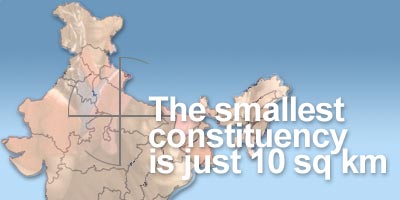Home > News > Elections 2004 > Special
The Rediff Election Special/George Iype
April 12, 2004
 Once every five years, sometimes earlier, India holds a general election, the world's largest democratic exercise.
Once every five years, sometimes earlier, India holds a general election, the world's largest democratic exercise.
With clockwork precision the Election Commission ensures that people get the opportunity to decide who holds the reins of power.
The building blocks of this electoral exercise are the constituencies.
But not many know how the shape and size of Lok Sabha constituencies are determined.
rediff.com presents some facts on Lok Sabha constituencies.
How many constituencies has India been divided into?
543.
Who determines the size and shape of constituencies?
An independent Delimitation Commission.
What is delimitation?
Delimitation is the redrawing of the boundaries of parliamentary or assembly constituencies to make sure that there are, as near as practicable, the same number of people in each constituency.
What is the Delimitation Commission's job?
To create constituencies that have roughly the same population, subject to geographical considerations and the boundaries of the states and administrative areas.
How often does the Commission examine the boundaries?
The constituency boundaries are examined after the ten-yearly census to reflect the changes in population.
So has the Commission been redrawing the parliamentary constituencies every decade?
No. The government suspended delimitation in 1976 until after the 2001 census so that states' family planning programmes would not affect their political representation in the Lok Sabha. This has led to wide discrepancies in the size of constituencies, with the largest having over three million electors, and the smallest less than 50,000.
So a new Delimitation Commission is processing the constituencies these days?
Yes. The government set up a Commission in 2002 under the chairmanship of retired Supreme Court Justice Kuldip Singh. The redrawing of the constituencies as per the 2001 census is underway these days.
Is the current general election being held according to the old delimitation of constituencies?
Yes.
Which are India's five biggest constituencies voters-wise?
Outer Delhi is the largest with 3,103,525 voters. It has 2,500 colonies and 182 villages, 21 assembly segments and 42 corporation seats. Most of the voters are migrants from Uttar Pradesh, Bihar and Punjab. It used to be a Congress bastion till the 1990s. The sitting MP is BJP leader and Labour Minister Sahib Singh Verma.
Thane in Maharashtra has the second largest electorate -- 2,832,514 voters. It has 13 assembly segments. The current MP is Shiv Sena leader Prakash Paranjpe.
East Delhi: With a voter strength of 2,473,271, this constituency mirrors what many people see a mini-India. The BJP's Lal Bihari Tiwari is the sitting MP.
Kanakapura: The constituency in Karnataka held by former prime minister H D Deve Gowda has roughly 2,402,692 voters.
Chennai North: The constituency has 2,041,341 voters. Dravida Munnetra Kazhagam leader C Kuppusami is the sitting MP.
Which are the five smallest constituencies voters-wise?
Lakshwadeep: It consists of 27 islands and just 37,619 voters. P M Sayeed, senior Congress leader and Deputy Speaker of the 13th Lok Sabha, has won all its elections so far.
Daman and Diu: The second smallest parliamentary constituency is a Union Territory. It has 72,216 voters. Congressman Dahyabhai V Patel is the sitting MP.
Dadra and Nagar Haveli: It has an electorate numbering 98,376. Located between Gujarat and Maharashtra, it is a Union Territory gifted with lush scenic beauty. Independent candidate Delkar Mohanbhai won from the constituency in the 1999 election.
Ladakh: It has 143,719 voters with four assembly segments -- Leh, Nubra, Kargil and Zanskar. Ghulam Hassan Khan of the National Conference is the sitting MP.
Andaman and Nicobar Islands: It is a Union Territory with 247,384 voters. The sitting MP is Bishnu Pada Ray of the BJP.
Which are the top five area-wise constituencies?
Ladakh (173,266 sq km), Barmer (71,601 sq km), Kutch (41,644 sq km), Arunachal West (40,572 sq km) and Arunachal East (39,749 sq km).
Which are the smallest five area-wise constituencies?
Delhi Sadar (28 sq km), Mumbai South Central (18 sq km), Mumbai South (13 sq km), Calcutta North West (13 sq km) and Chandni Chowk (10 sq km).
Image: Rahil Shaikh